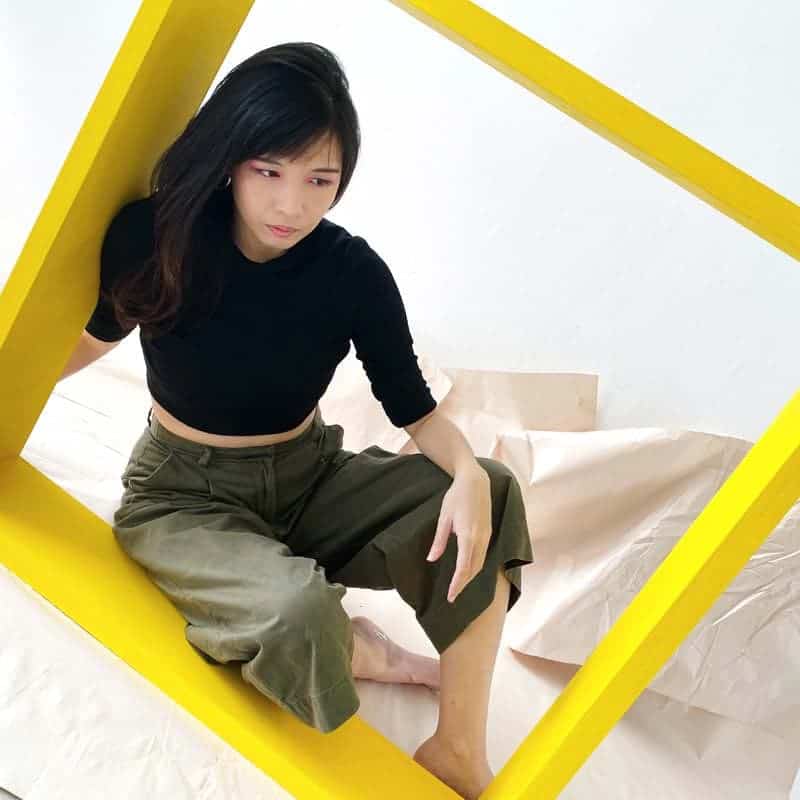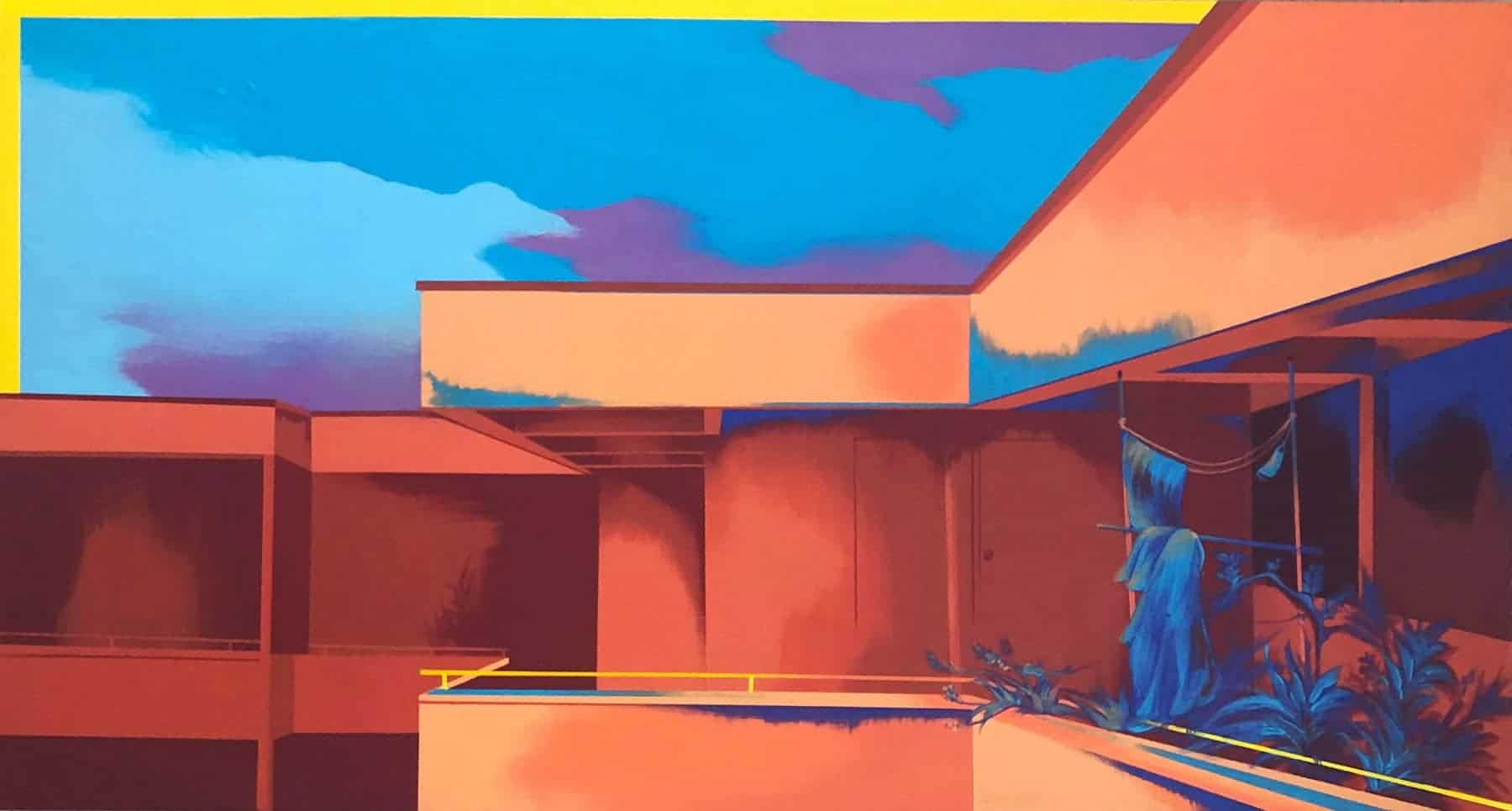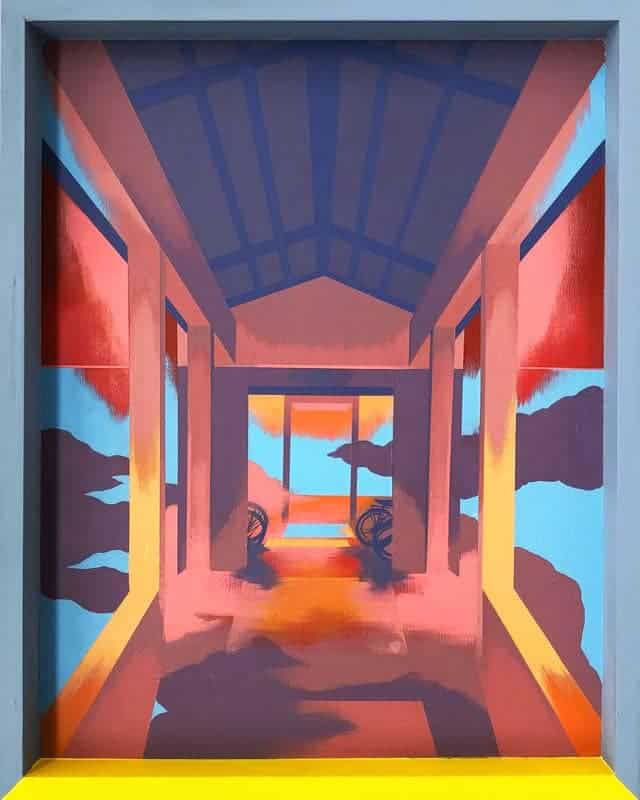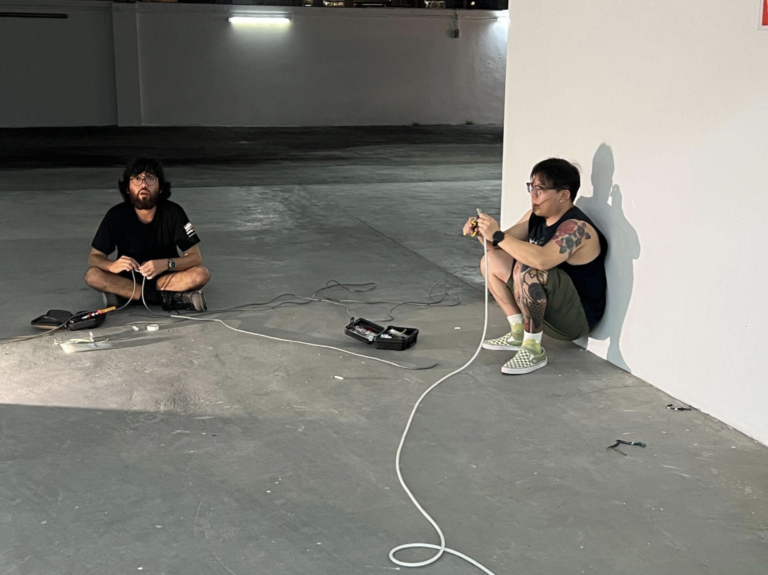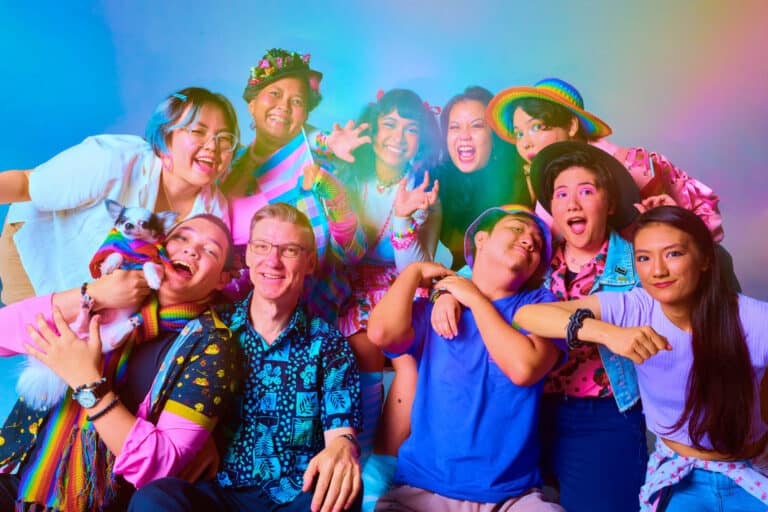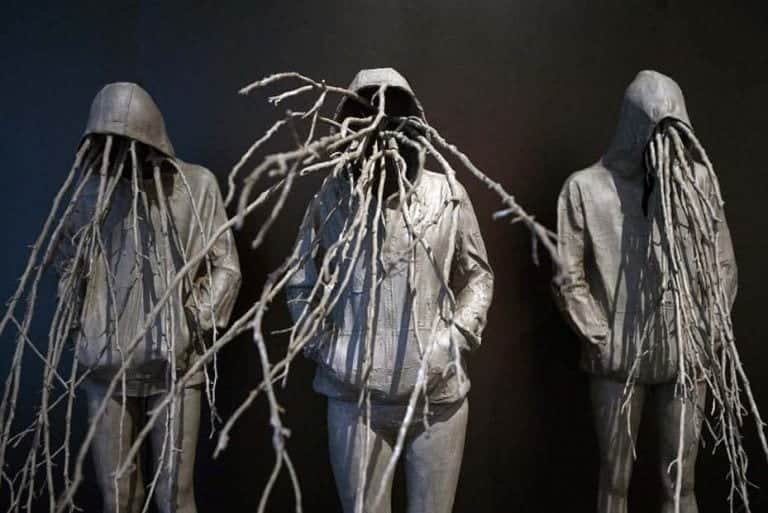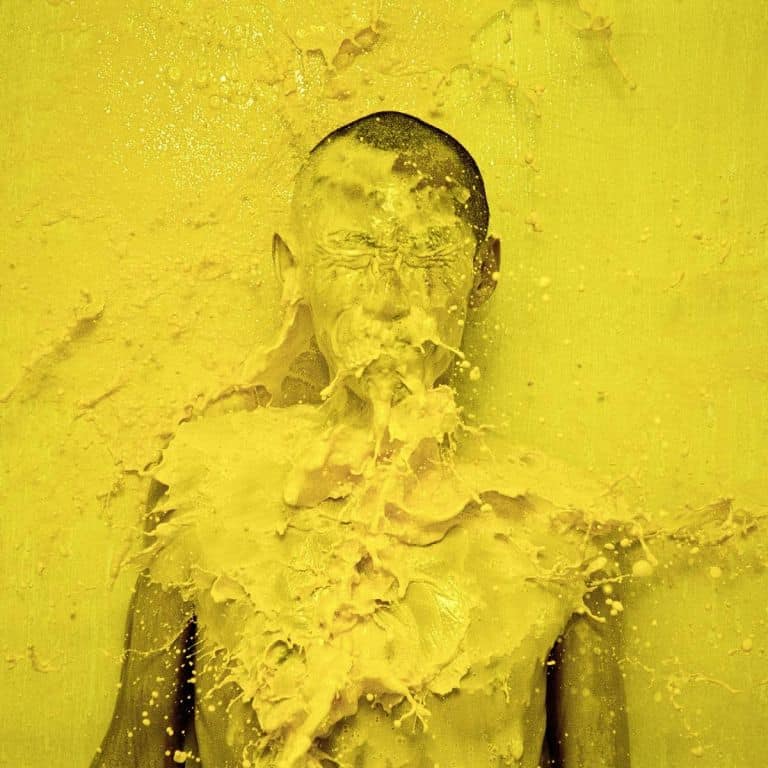A thin strip of yellow marks a trail through each work at visual artist Shen Jiaqi’s first solo show, Comfort Zones, at Coda Culture. This visual symbol is a familiar sight to most of us; we see it along the roads and on escalators. At the bus stop. Demarcating smoking corners and the mostly-defunct bike-share parking spots.
Boundary boxes and warning lines such as these have only become even more commonplace in recent times. In the early days of the pandemic, red and yellow tape markings sprouted overnight in response to the social distancing rules that were only just being introduced then.
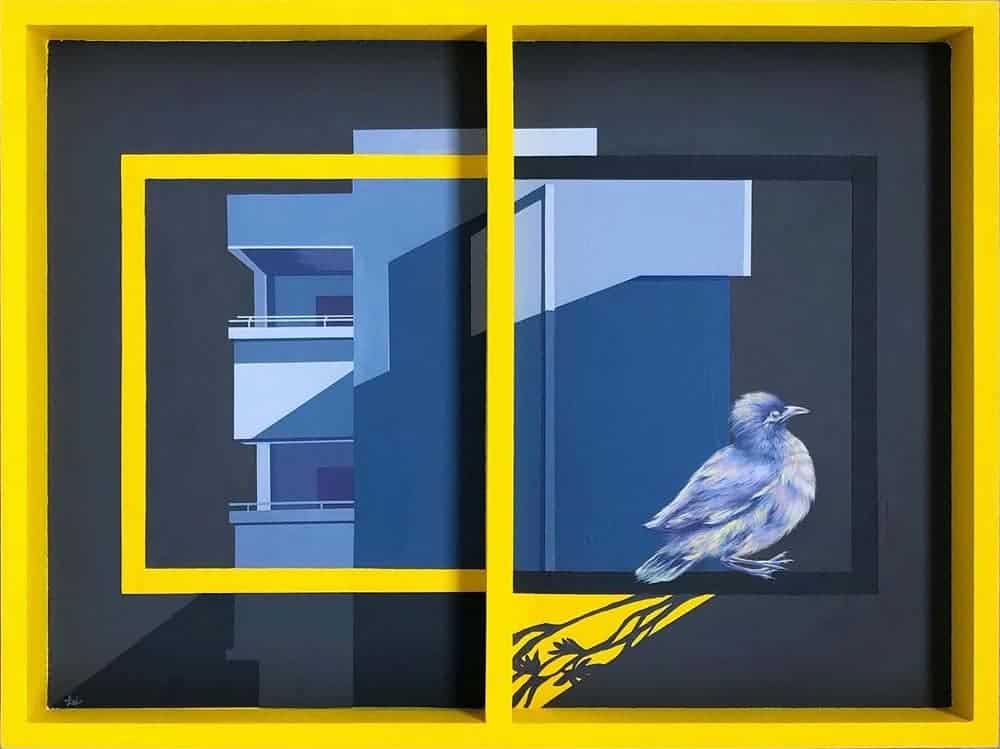
“These yellow lines suggest that danger lies beyond, and warn you not to venture beyond the safety of the comfort zone. They stop us from going somewhere dangerous, but this also means that they stop us from going somewhere that could mean better for us,” says the artist. The body of works that she presents in Comfort Zones is a response to the metaphorical and literal comfort zones that she has been grappling with in both her life and work.
After being in the civil service for eight years, Jiaqi recently left the comfortable certainty of her teaching career for the precarious waters of being a full-time artist. To say that she has left her comfort zone would be an understatement, considering that she has also chosen to make this leap during a time of pandemic and global recession. It’s a life circumstance that I can’t help but empathise with, seeing as I had also exited the teaching service just several months prior to Jiaqi herself.
She charts her decision down to her discomfort with what she views as the inability of the education system to accommodate the needs of our present-day youth, and prepare them for an increasingly unstable future. She says:
“As a teacher, I witnessed too many of my students and colleagues struggle with trying to balance and fit into expected modes of behaviour when they are within the education system. Many of my students had issues that the system simply does not have the flexibility and progressiveness to cope with. This weighed on me mentally. As an artist, I feel very driven to speak out and create change against certain injustices and outdated restrictions, but of course I could not do that in my professional capacity as a teacher.”
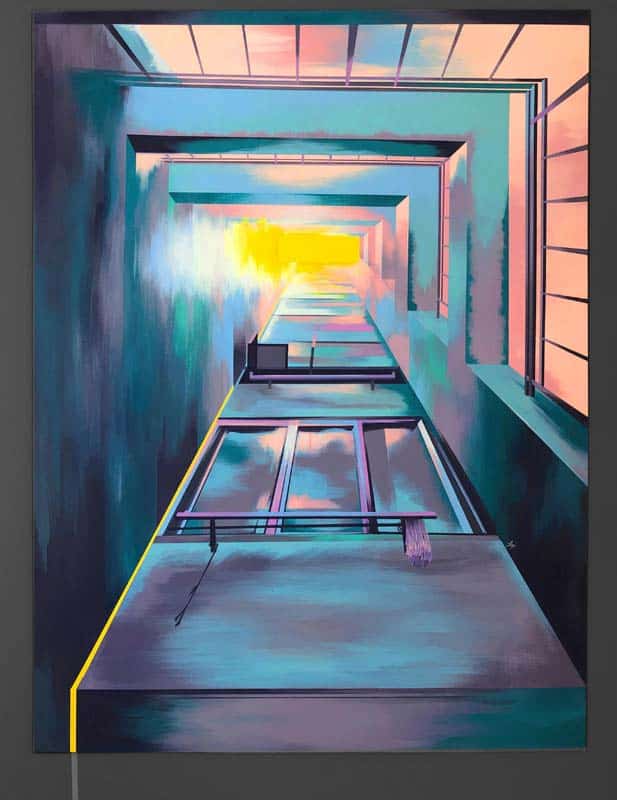
Knowing this, works such as Ribbit and Guide to the desired outcome can be read as subtle critiques of the education system and the Singaporean way of life. The title of the former is taken from the sound that a frog makes, and references the Chinese idiom, “frog in a well”, used to refer to individuals that are close-minded because of their sheltered upbringing.
The work depicts the upward view of an HDB block in one-point perspective, as though the viewer were looking upwards into a skylight. A thin strip of yellow leads the gaze from the bottom of the picture plane to the top, where a blindingly yellow glow seems both hopefully bright, yet obstructively opaque.
Situating the viewer at the bottom of this dingy, well-like passage, the artist seems to suggest that the path to enlightenment and freedom eludes us frogs, barricaded in by barriers of institutional making.
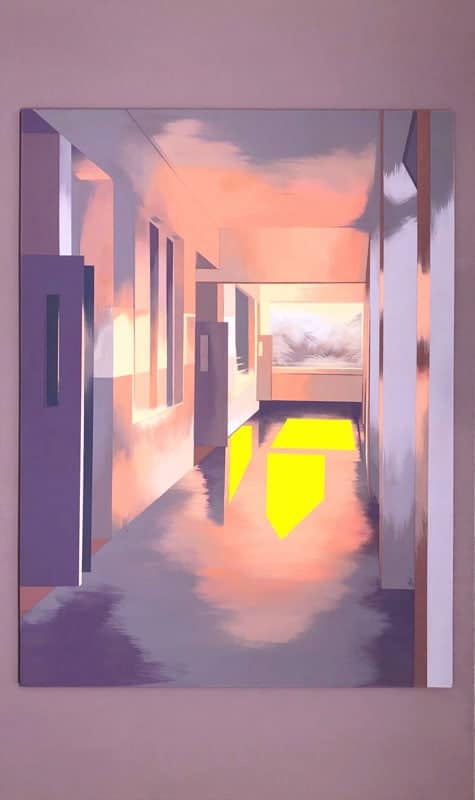
Guide to the desired outcome seems at first glance a less austere outlook, awash in calm with its plum and rose-pink tones. The scene is of the classrooms at dawn, before the chaos of the school morning sets in when the students arrive en masse. Chancing upon this scene one week prior to her last day at work, Jiaqi shared that she felt an odd sense of sentimentality and nostalgia for the place.
“I was contemplating how there are these set paths that our youth are guided towards – desired outcomes of education. The reason why I’m leaving is because too much veers from it and it’s very hard for the system to adapt,” she says. To the artist’s mind, the yellow trapezoidal shapes on the ground were the narrow areas that students were allowed to explore, though in actuality there lay a far wider range of options that they should be allowed to consider, beyond those yellow boxes.
As much as these boundary lines were created to protect us from danger, they also restrict in equal measure. It’s a comfort that one must necessarily trade off with freedom, and a comfort that the artist has grown to feel the need to challenge.
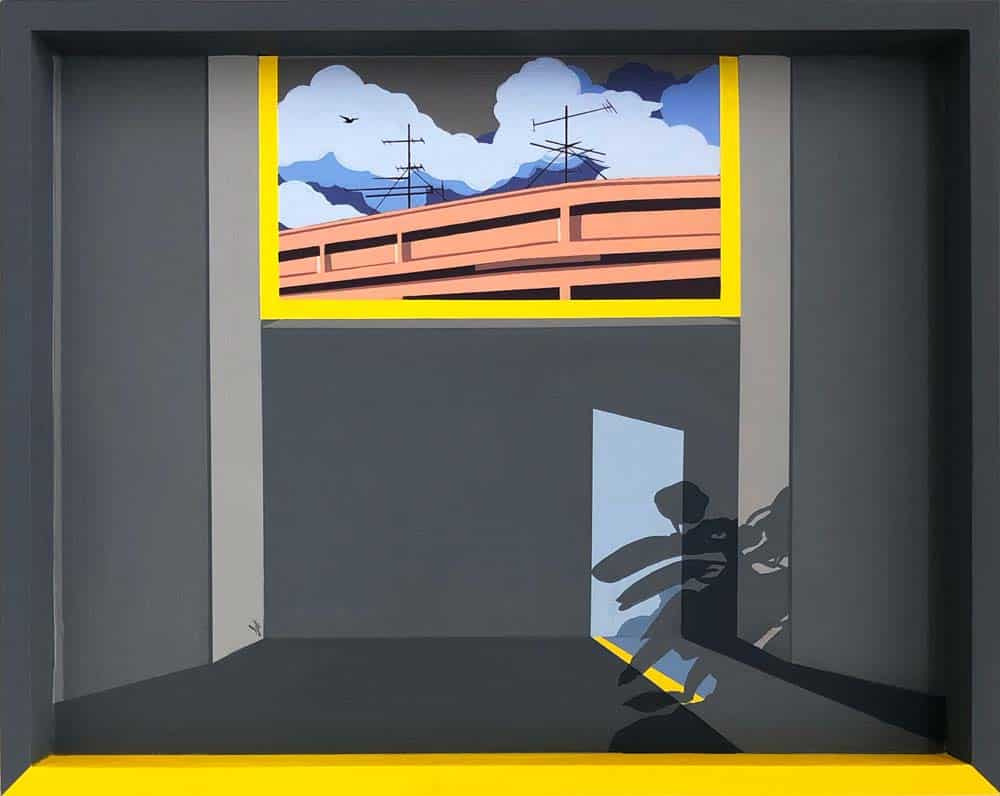
This yearning for that which lies beyond the confines of safety can perhaps be best felt in Memory of Flight, where yellow lines frame the window of a drab jail-like room. Out there, in the distance, a bird is soaring, a pinprick silhouette against cotton candy clouds. In here, the shadow of a plant lurking in the doorway gains anthropomorphic characteristics. One imagines it us, rooted to this undesirably plain room and looking enviously on at those who have managed to chase freedom.
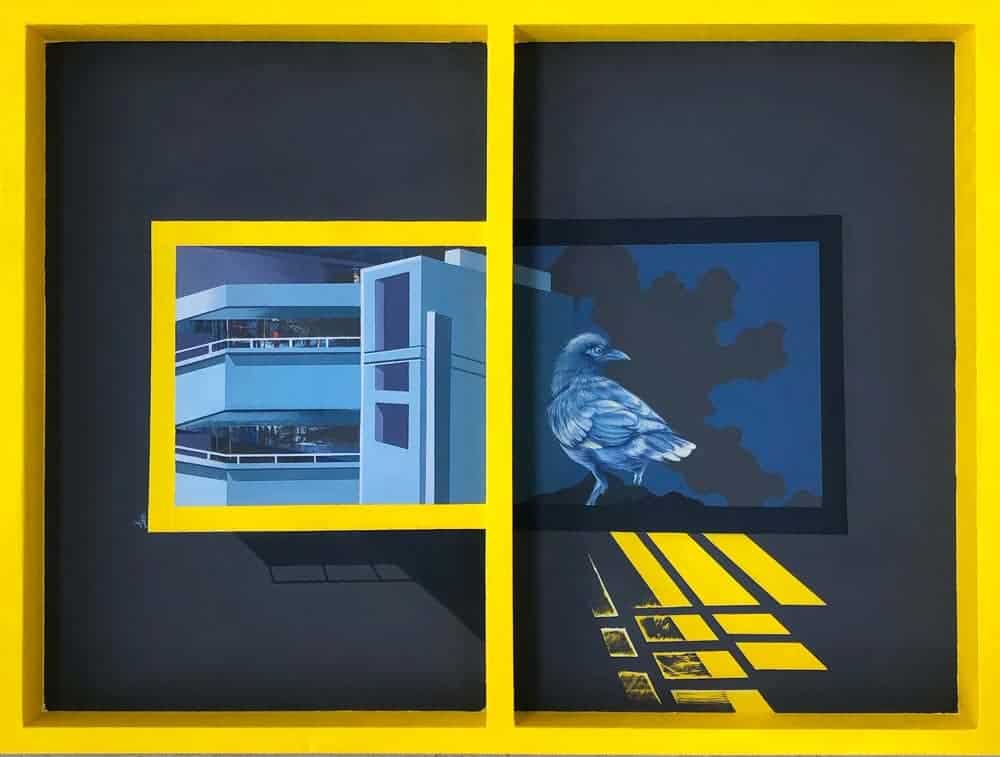
In a similar vein, the subverted symmetry of Certainty is the calm before the storm reflects this tension between comfort and freedom, and the apprehension that fills us when we are caught between the two.
The stark yellow lines on the left side of the work are painted over on the right, in mimicry of roadwork conventions where unwanted yellow road markings are covered over with extra tarmac. Yet, those yellow lines never truly become erased, as the dark grey lines form raised bumps that mark where they once stood.
The bird stands on one such line, looking back as though uncertain of its next move. It may have left the clear confines of the school building that lay well within the boundaries of the yellow box on the left half of the painting, but is it free yet? Perhaps physically, but not yet in the mind. It makes me wonder how many of us remain shackled by unspoken expectations of the rules that we think we have to follow, even when it is not explicitly disallowed.
Back when I was still a teacher, I felt that I had to keep the non-conforming parts of my identity hidden because it would lead to trouble. After all, god forbid some parent complains to the national newspapers that the Ministry is anything less than pro-family. Did anyone ever say that I was not allowed to disclose my sexuality? No. Did I nonetheless feel claustrophobic to the point that I felt that I needed to leave the teaching service in order to be truly and authentically myself? Certainly.
Jiaqi’s work resonated with me because of all the markers of permissibility that I – and any Singaporean – invariably has to contend with. I ask her if she thinks of herself as the bird in Certainty, and she says, “I see all of us as the bird. The bird is us, hovering on the line that may or may not exist, and constantly looking back.”
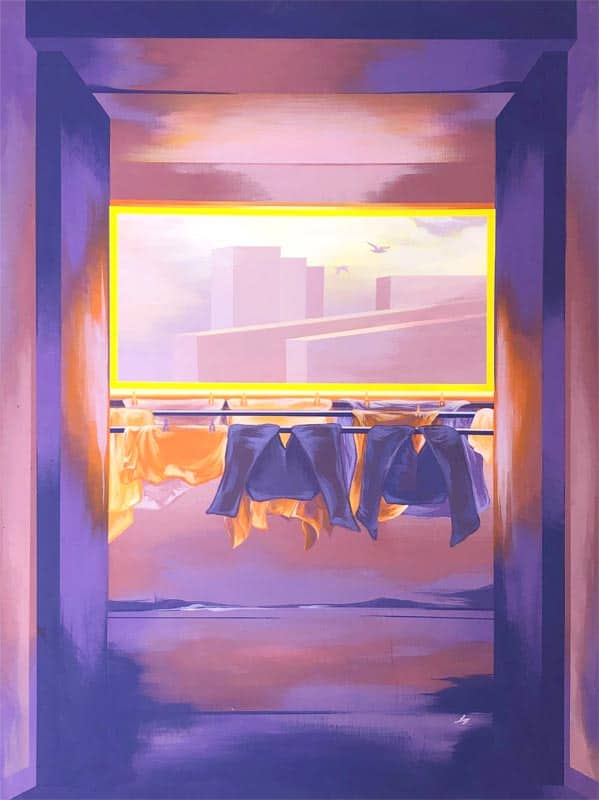
Will there be a day when unbridled freedom is the norm rather than the exception? The artist seems to ask in the work entitled Waiting for the day. With its jewelled hues and an edenistic outlook in the window at the centre of the picture plane, it seems a hopeful thought. But then again, the authoritative yellow tape asserts itself, framing that otherworldly utopia as a danger not to be desired. This is not to say that boundaries are to be monolithically disregarded – but one should exercise one’s own judgment and consider why they are drawn, and if those considerations apply to one’s own circumstance.
The artist uses this visual motif to segregate the viewer and the scene, provoking us to consider our relationship with the spaces that we inhabit and the privilege that we may possess that others don’t. The single yellow bar across the bottom of the panel of Routine Reverie may read as an obstruction that bars the viewer from the fantastical scene that lies beyond it, indicating a separation between mundane reality and the wishful dreams. In such a scenario, perhaps we are better off with these warning lines, keeping us tethered to reality.
The entire frame of Another’s Path has been coated in yellow, as if underscoring the separateness between the beholder and the scene, even though what lies beyond is a far more mundane-looking scene than the one depicted in Routine Reverie. In this work, the portal-like implication of the yellow boundary is used to two effects: one separates the viewer from the scene, while the other partitions one interior space from yet another ensconced more deeply within the painting.
This narrow doorway, the artist shares, is the separate door built for workers to access the water tank on the 13th floor of her HDB estate. Living on this level, she only learnt of this alternate reality when the door was left unlocked by one of the workers one day. She peered in and realised that there was a completely different reality than the one that she navigated on a daily basis.
This work rings especially timely in light of how foreign workers have been confined to dormitories since the Circuit Breaker began. At the time of writing, these measures have reportedly begun to take a toll on the workers’ mental health, prompting concerns over whether adequate steps have been taken to protect the wellbeing and livelihoods of these workers amidst the pandemic.
The artist thus asks us to consider how much of the comfort zones that we inhabit as free-ranging citizens has been at the expense of a diminished comfort zone of others. When we draw the lines between us and them, whose comfort are we protecting, and whose safety is preserved? The works at Comfort Zones, by and large, are all rather visually stunning, but you won’t find any easy answers to the questions that they provoke. Rather, you might well leave the show having had your comfort zones disturbed – but you can’t say you haven’t been warned.
I ended up purchasing a work from the show, even though some might say that my current life hustling as an arts freelancer makes art, ironically, a luxury that I cannot afford. Can I eat this? No. Will it pay my bills? No. Do I even own a home that I can hang it in? I wish.
But I suppose that is the allure of art: that it sometimes has the power to convey a point of view so compelling that money begins to feel like a cold, impersonal object that is well worth the swap. I’d call it support for a fellow bird who has flown the coop, except to do so would be to trivialise the strength of her perspective and her courage to challenge our collective comfort zones.
______________________
Comfort Zones is ongoing at Coda Culture until 5 September. Please email codaculturesg@gmail.com if you would like to enquire about the works.
All images in this article are courtesy of the artist and Coda Culture. Feature image: Shen Jiaqi, How did it get so late so soon, 2020.
